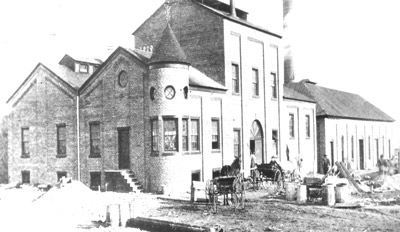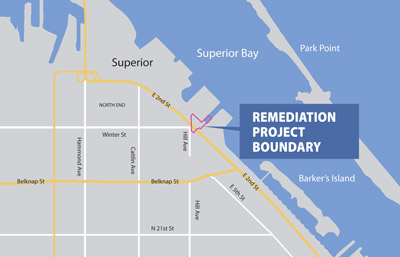Former Manufactured
Gas Plant Remediation
Project
Superior Water, Light and Power is partnering with the Wisconsin Department of Natural Resources and the Great Lakes National Program Office, or GLNPO, of the U.S. Environmental Protection Agency to remediate impacts from a former manufactured gas plant in Superior, Wisconsin. The plant operated in Superior more than 100 years ago.
Contact Us
History
Manufactured gas plants, also known as MGPs, existed throughout the United States in the mid-1800s and early 1900s. They used coal and oil to produce gas for lighting, heating and cooking. However, as natural gas became more widely available, the production of manufactured gas declined. Wisconsin has dozens of former MGP sites across the state. SWL&P’s manufactured gas plant operated for 15 years, from 1889 to 1904, along the St. Louis Bay waterfront. After the manufacture of gas at the site ended, the company continued to store gas there until 1959. Today, the site is in a largely industrial area with some commercial and residential properties nearby.

Site information and remediation
The gas manufacturing process and later gas storage generated oily/tar-like waste and a lighter petroleum waste which were released into the subsurface soils and groundwater. Based on recent site investigations, the most significant contaminants are volatile organic carbons, also called VOCs, such as benzene, toluene, ethylbenzene and xylenes (petroleum-like) and polynuclear aromatic hydrocarbons, or PAHs (tar-like). Most of the waste is located below the ground surface, minimizing the risks of exposure to human health and the environment.

The remediation is divided into two phases
The upland remediation phase took place in 2023 with the majority of construction activities completed by October of last year. A second phase will get underway in 2025 and will focus on the C Street Slip near the City of Superior’s Wastewater Treatment Facility. The upland remediation includes excavation of impacted soil and the installation of a biosparge system for areas that cannot be accessed by excavation methods.
- Several thousand cubic yards of impacted soil were excavated and disposed of at a licensed off-site facility. All captured groundwater generated from excavation activities was sent through an on-site treatment facility before being sent to the municipal waste water treatment plant (WWTP).
- The biosparge system uses a series of blowers and wells that inject air into the ground to enhance biodegradation of any remaining contaminants. The extracted air is run through an activated carbon filtration system to remove airborne contaminants.

FAQs
Click here to read frequently asked questions.


